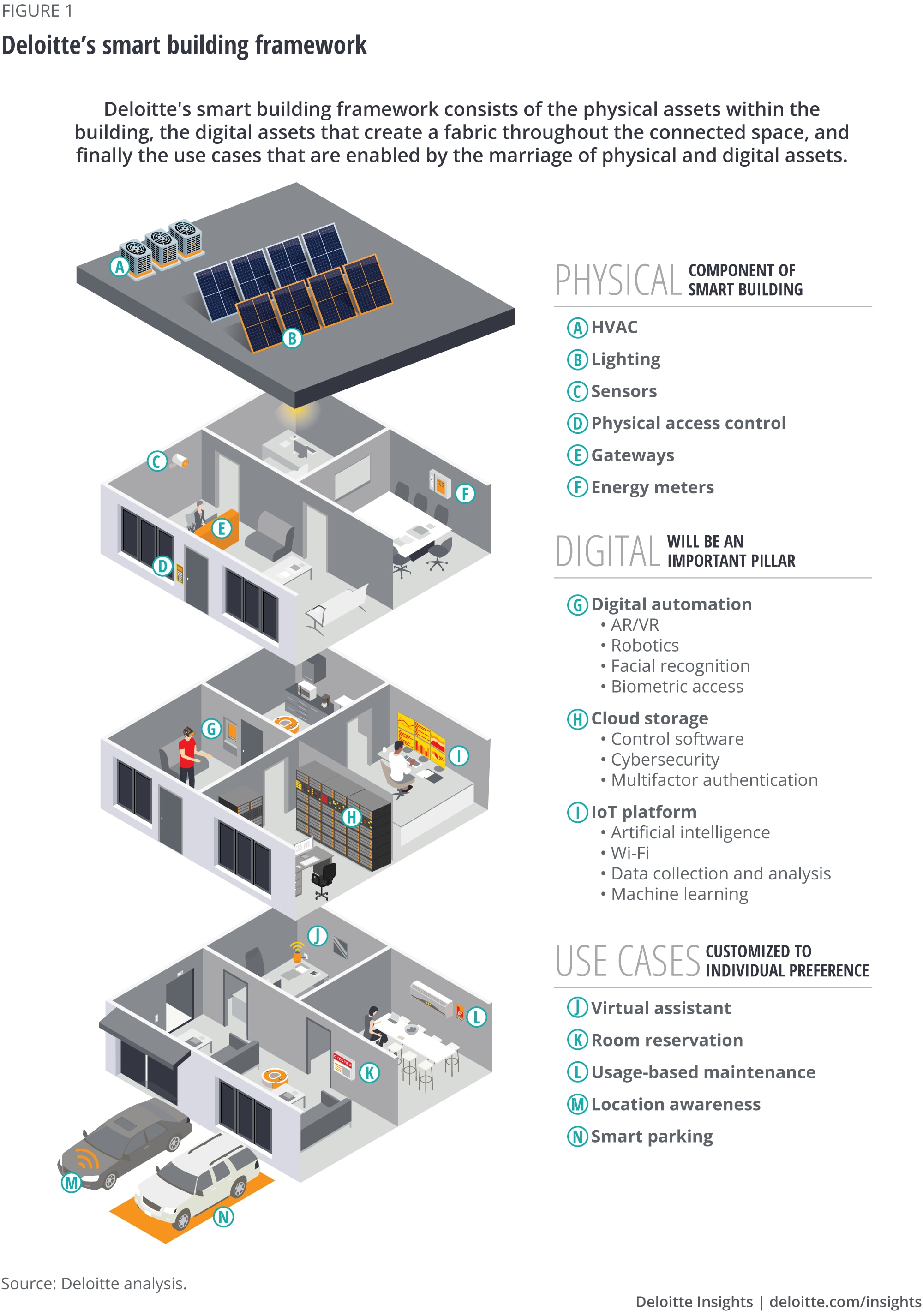
Smart buildings Four considerations for creating people-centered smart, digital workplaces
11 minute read
14 December 2018
As digital technologies enable the creation of smart, digitally connected spaces, businesses should consider four aspects that would place people at the center of their smart buildings.
The confluence of the Internet of Things (IoT) with building operations and the future of the workplace is creating a significant opportunity for building owners, operators, and occupants to create smart, digitally connected spaces that support the people at their center. Business leaders are increasingly interested in creating a strategy for managing their buildings that reflects the digital transformation taking place throughout their business. Those that do may outpace their competitors in key areas such as employee attraction and retention, operating cost savings, and operational risk mitigation.
What are smart buildings?
The world is awash in “smart” things, as the term has become synonymous with embedding an inanimate object with network connectivity and the ability to communicate and/or interpret data about the object’s status, performance, or behavior. Take, for example, smart cities, which include connected infrastructure ranging from physical assets such as parking meters, to streetlights and trash receptacles. Deloitte’s smart cities research has expanded the initial definition to a Smart City 2.0 version, which encompasses not only connected infrastructure, but also the goal of higher quality of life for citizens. Smart City 2.0 uses three Ds—data, digital, and (user) design—to enhance citizens’ experience and city decision-making.1
In much the same way, smart buildings seek to encompass a logical, physically proximate grouping of smart things. At their most basic, smart buildings are digitally connected structures that combine optimized building and operational automation with intelligent space management to enhance the user experience, increase productivity, reduce costs, and mitigate physical and cybersecurity risks. Smart buildings span industries—they include office buildings, factories, shopping malls, hospitals, academic campuses, stadiums, airports, military bases, and residential buildings. The common thread running through these use cases is human—these are all spaces in which humans can converge and interact with each other, utilize advanced technology to perform their necessary functions, and benefit from a digitally enhanced experience. Deloitte’s smart building framework consists of the physical assets within the building, the digital assets that create a fabric throughout the connected space, and finally the use cases that are enabled by the marriage of physical and digital assets (see figure 1).
Smart buildings are digitally connected structures that combine optimized building and operational automation with intelligent space management to enhance the user experience, increase productivity, reduce costs, and mitigate physical and cybersecurity risks.

Why are smart buildings important?
Smart, digital buildings span industries and uses, but all of them can provide the same basic capabilities: they connect humans; they provide better control of facilities and operations; they support ways to collaborate digitally; and they enable owners to conserve resources that include space, energy, water, and employees. Each of these four capabilities can form the basis for creating a smart building strategy that can deliver a number of measurable benefits (see figure 2).

Bringing people together in connected, digital workplaces
Today’s workplaces have changed dramatically from the days of cubicle “farms” and oversized conference rooms. As trends such as the globalization of business, remote work, and coworking have taken off, technologies have evolved to support a distributed workforce, altering the physical space needed for workgroups. Wi-Fi and cellular networks support mobility throughout an office and beyond it, offering immediate, zero-latency access to key services, information, and insights that improve operations and employee productivity.
What does connectivity in a smart building enable? It creates a level of visibility that was previously impossible, allowing for the workforce to make more efficient use of space and their time, enhancing productivity. Using in-building, real-time location services, for example, to connect people within a physical workplace, can answer questions such as, “Where is my coworker sitting today?”, “Where is space available for us to have a meeting?”, and “Is it busy in the cafeteria right now?”. Additionally, services such as secure, wireless printing and one-touch dial-in for conference calls are enabled by connected, digital workplaces.
In today’s tight job market, connected digital workplaces also enable companies to differentiate themselves by providing exceptional levels of employee experience and human comforts that can help employers attract and retain talent. Indoor wayfinding, digital signage, smart kiosks, wireless charging, and even concierge services can all be enabled through a connected workplace and set an employer apart. In fact, organizations with strong online social networks can be 7 percent more productive than those without and when employee engagement increases, there tends to be a corresponding increase in employee retention by up to 87 percent.2
Supporting new levels of digital collaboration
Experts in workforce management, innovation, and human capital have all identified the benefits that can be gained from enhancing collaboration among coworkers. Ongoing research on workspaces has reported data that suggests creating “collisions”—chance encounters and unplanned interactions among coworkers—improves performance.3 Many businesses have been reconfiguring office layouts and creating a mix of closed and open spaces over the past decade in the hopes of sparking encounters that drive new collaborations.
The technology available in smart buildings today can take collaboration to entirely new levels. For coworkers that are physically proximate, smartboards and smart conference rooms can foster collaborations and capture their outcomes. Additionally, video conferencing and virtual meeting walls can bring physically remote coworkers into an environment that can spark more creative interactions. And, the ability of a connected workplace to sense and respond to the coworkers that are present is a particular advantage of smart buildings. Layering in tools such as virtual digital assistants and wireless content sharing makes collaboration effortless.
All this increased collaboration typically has tangible benefits. Some companies have reported increasing annual employee productivity. Others identify faster new product development cycle times and increased sales as the result of creating workplaces that foster communication and collaboration across corporate functions and workgroups. Additionally, levels of employee engagement generally increase when the workspace supports interactions and communication. Humans have a natural affinity for places that allow congregation, friction, and interaction.4 Using real-time data analytics and digitally integrated furniture, for example, to spur these interactions could empower new levels of employee engagement.
Optimizing the control of facilities
The first “smart” buildings enabled automation of common building operations, notably with climate control and secure building access. This aspect of smart buildings has had the benefit of more than a decade of technology evolution, and is poised to fully leverage today’s advanced technologies such as the IoT, Wi-Fi, cloud analytics, and mobile devices. Facility management in smart buildings has become a complex orchestration of a portfolio of services that are both physical and digital. It can include optimizing aspects such as space, temperature, and lighting, along with providing the highest levels of cyber-physical security and access control. Today, it elevates control across a portfolio of services and capabilities that enable facility operators to maximize their efficiency and effectiveness of the space.
The benefits related to optimizing the control of building operations are well documented, and reveal some of the most directly attributable outcomes from smart buildings. Optimizing and improving the operations of the facility can lead to a variety of recouped costs, starting from major saving on bills related to heating, cooling, lighting, and maintenance. For example, on average, 50 percent can be saved by moving to a connected lighting system.5 This can be achieved by creating a digital control tower for building operations, which provides real-time insight and leverages machine learning and artificial intelligence to calibrate services across a building. Even something as simple as identifying which workspaces or bathroom facilities have been used and need cleaning can result in measurable cost savings.
Enhancing resource conservation
Corporate environmental sustainability has become a watchword in today’s global business markets. Companies across industries are seeking ways to codify their environmental, health and safety (EHS) and sustainability efforts in response to customer, shareholder, and regulatory demands. Smart buildings can be central components of sustainability and EHS programs. Space utilization is one of the highest sources of waste in most business settings today, despite the fact that average square footage per employee has shrunk considerably in the past decade.6 Industry reports have indicated that on average only 56 percent of work seats are utilized, while the remaining 44 percent remain vacant. Even at peak seasons and times, upward of 30 percent of seats remain empty the majority of the time.7 Using analytics to identify office space usage and reducing office footprints to reflect actual occupancy can save considerable costs related to overhead, operations, and resource consumption.
Energy conservation is another source of interest for business owners, and one that delivers a dual benefit of supporting the environment and providing cost savings. Connected building technologies enable better coordination of energy audits, allowing providers to perform usage assessments that empower better energy procurement contracts, identify opportunities for reducing consumption, and suggest alternate energy sources, including renewables and micro-grids. Companies that implemented IoT-enabled sensors and smart devices have seen energy savings of up to 70 percent in three years.8
In addition to space utilization and energy conservation, waste management is an important component of conservation that can be optimized through smart building technologies. For example, The Edge, a Deloitte smart office building, collects rainwater to reuse in the sanitation system.9 Other examples of waste conservation include the use of smart bins and robotic sorting, which can significantly increase the operational efficiency of the facility. Radio-frequency identification (RFID) tracking and fill sensors can detect fill levels and monitor the materials that can be recycled and reused. This could reduce both the time and energy required for waste management services as well as the amount of waste created.
What’s the best approach for implementing smart buildings?
Given the opportunities involved in leveraging smart buildings to drive employee engagement, cost savings, energy efficiencies, and more, many business leaders are eager to adopt smart building technologies. However, it is important to establish a strategy around smart buildings to avoid some of the common pitfalls that many of these individual efforts produce (see sidebar, “Common pitfalls to avoid when designing smart buildings”). An effective strategy should define a holistic set of requirements that spans across functional areas such as IT, operations, human resources, corporate real estate, and security. It should also identify the team of key stakeholders based on these requirements, and prioritize use cases from the requirements to establish realistic time frames and make the right investments in proofs-of-concept and full-scale implementations. All of these can be essential to making the most of a smart building initiative.
Common pitfalls to avoid when designing smart buildings
- Spending money on technology or solutions without a clear strategy or benefit
- Not considering the human needs in the solution, i.e., only looking at facility needs
- Not being able to measure savings
- Not putting in multipurpose infrastructure
- Failing to create a comprehensive cyber-physical security system
- Collecting data without identifying its purpose/business goal
- Choosing to focus on energy conservation rather than space conservation
- Failing to build in flexibility for future technology enhancements
Start with the objectives
It is important to frame a smart building initiative in the context of the overall business objectives. Because of the vast array of directions in which an initiative can go, leaders should identify the important capabilities within connect, collaborate, control, and conserve, and prioritize them within a strategy. For example, approaching an initiative through the lens of workplace strategy may focus on the connect and collaborate capabilities. Leaders could start by reviewing how people would like to use a building or space and create requirements that are framed through the users’ experience to identify smart building technology that supports these requirements. Similarly, if leaders are more interested in building operations, they would identify the capabilities within control and/or conserve to focus their strategy around the intersection of building and operational automation using smart building technologies.
Understand the role technology plays
By their very definition, smart buildings are all about technology. It is the rise of advanced technologies that has enabled the new generation of capabilities and digital services within office buildings, factories, retail establishments, and more. A number of key technologies have created the foundation for smart buildings, including the IoT, cloud infrastructure, data analytics, machine learning, and artificial intelligence. Equally important is the convergence of two very important areas within the smart building: IT and operations. Increasingly, the IT infrastructure that powers the information-driven digital workplace also becomes a core foundation for connected building automation, for cyber-physical building security, and other operational aspects of the building itself. A smart building strategy should incorporate all aspects of technology, which can be grouped into three categories that are part of Deloitte’s smart building framework: physical, digital, and services (see figure 1 for more details).
Pick the team
Through the identification of the business objectives and the necessary technology infrastructure for enabling smart buildings, it becomes apparent that the team of stakeholders should be diverse to reflect the broad reach of these initiatives. While the composition of a smart building strategy team will vary by use case and situation, there are several common roles that represent the complexity of these projects and can help with their success:
- Real estate/facilities leaders: Depending on the scope of a project, it may be the commercial real estate function or a facility manager who represents the perspective of building assets.
- Operational leaders: These could include the chief information officer, chief operations officer, chief sustainability officer, chief human resource officer, or even chief financial officer. Their role is to represent the operational goals of the smart building initiative and bridge the technology-operations conversations with their IT counterpart.
- Technology leaders: This could include the chief technology officer, cybersecurity officer, or other IT leaders that are responsible for managing the network infrastructure and information backbone.
Possibly the most important aspect of selecting a smart buildings team is to ensure that representatives of the business goal for the initiative and the enabling functions come together to agree upon the purpose, scope, and timeline for the initiative.
Using a project-based approach with smart buildings
Once leaders start to consider how to frame a strategy for smart buildings, there are some methods to consider for making progress with an initiative. One that has worked repeatedly across different types of smart building initiatives is a project-based approach. With this method, the smart building team identifies the first group of use cases that align with business objectives and launch a project to plan, test, and scale them. Below are a few suggested steps leaders can take.
- Understand the current state and requirements. Start to crystallize the smart building vision and business and functional objectives. Engage with various stakeholders to determine the business needs, build the team that aligns business and IT stakeholders, and gather requirements for the project.
- Conduct a gap analysis relative to future opportunity. Identify gaps between the current and future state requirements to enable the team to develop an inventory of use cases based on requirements and current capabilities. Workshop sessions can be structured to prioritize use cases and establish a road map, often by taking a group of linked use cases that make up a user journey. This can form the basis for a proof of concept (PoC).
- Implement a PoC. It should include use cases that deliver measurable value based on business priorities. The PoC typically involves several layers, including a use case technical architecture, a “sandbox” for development and testing, and a means for collecting and analyzing data from the outcomes. Once the PoC runs, capture and analyze the results to determine the viability of the solution if it is to be scaled.
- Launch at-scale implementation. This phase will often require a number of other activities to reach scale. At the same time, the team could circle back to the smart building strategy and identify the next group of use cases that can be launched as the second project. In this way, the development, testing, and deployment of smart building initiatives can be continuous and staged to meet resource constraints.
Smart buildings hold a significant amount of promise and potential for savvy building owners and operators. The rise of smart, connected devices and ubiquitous connectivity have created an opportunity to transform buildings—whether they are offices, retail stores, factories, or hospitals—into cost-efficient, responsive environments for delivering exceptional experiences to their occupants. Business leaders who identify the potential of smart buildings can reap tangible benefits, from reduced overhead to greater corporate sustainability and better talent retention. Given the pace of this evolving market, the most important thing could be to start by forming a smart building strategy.
© 2021. See Terms of Use for more information.
Explore the Internet of Things collection
-
Internet of Things Collection
-
The Internet of Things: A technical primer Article7 years ago
-
The design of things: Building in IoT connectivity Article8 years ago
-
Power struggle: Customers, companies, and the Internet of Things Article9 years ago












